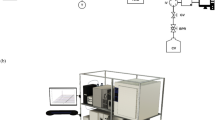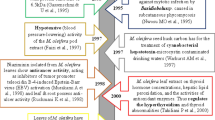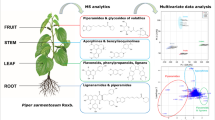Abstract
Ergot alkaloids are toxins produced by some species of fungi in the genus Claviceps, that may infect rye and triticale and, in a minor degree, other types of cereals. In this study, a new UHPLC-FLD method for the quantification of the six major ergot alkaloids as well as their corresponding epimers was developed. The sample preparation was done by a solid-liquid extraction with acetonitrile and clean-up via freeze-out. The method was fully validated and then applied to 39 samples (wheat, rye, triticale, and barley) harvested in Luxembourg in 2016. Samples were sieved (1.9 × 20 mm) prior to analysis in order to remove sclerotia, hosting the alkaloids. However, 23 samples still contained at least one ergot alkaloid > LOQ and concentrations of the sum of the 6 ergot alkaloids ranged from 0.3 to 2530.1 μg/kg. Interestingly, the highest concentrations were measured in wheat and not in rye or triticale, suggesting that all kinds of cereals should be included in monitoring programs. The outcome of this study allowed giving a first overview of ergot alkaloid concentrations in cereals harvested in Luxembourg, and the measured concentrations were in similar ranges than in other parts of the world (e.g., Canada, France, Germany).



Similar content being viewed by others
References
Arroyo-Manzanares N, De Ruyck K, Uka V, Gámiz-Gracia L, García-Campaña AM, De Saeger S, Di Mavungu JD (2018) In-house validation of a rapid and efficient procedure for simultaneous determination of ergot alkaloids and other mycotoxins in wheat and maize. Anal Bioanal Chem, in press
Baumann U, Hunziker HR, Zimmerli B (1985) Mutterkornalkaloide in schweizerischen Getreideprodukten. Mitteilungen aus dem Gebiet der Lebensmittelhygiene 76:609–630
Berde B, Stürmer E (1978) Introduction to the pharmacology of ergot alkaloids and related compounds as a basis of their therapeutic action. In: Berde B, Schild HO (eds) Handb Exp Pharmacol. Springer, Berlin, pp 1–28
BFR – Bundesinstitut für Risikobewertung (2004) Mutterkornalkaloide in Roggenmehl. Stellungnahme des BfR vom 22. Januar 2004, Berlin, pp 1–10
Blaney BJ, Molloy JB, Brock JJ (2009) Alkaloids in Australian rye ergot (Claviceps purpurea) sclerotia: implications for food and stockfeed regulations. Anim Prod Sci 49:975–982
Burk G, Hobel W, Richt A (2006) Ergot alkaloids in cereal products – results from the Bavarian Health and Food Safety Authority. Mol Nutr Food Res 50:437–442
Crews C (2015) Analysis of ergot alkaloids. Toxins 7:2024–2050
Di Mavungu JD, Malysheva SV, Sanders M, Larionova D, Robbens J, Dubruel P, Van Peteghem C, De Saeger S (2012) Development and validation of a new LC–MS/MS method for the simultaneous determination of six major ergot alkaloids and their corresponding epimers. Application to some food and feed commodities. Food Chem 135:292–303
EFSA – European Food Safety Authority (2012) Scientific opinion on ergot alkaloids in food and feed. EFSA J 15:2798–2956
EFSA – European Food Safety Authority (2017) Human and dietary exposure to ergot alkaloids. EFSA J 10:1–53
EUROSTAT, publication ISSN 2443-8219 (2017)
Flieger M, Wurst M, Shelby R (1997) Ergot alkaloids - sources, structures and analytical methods. Folia Microbiol 42:3–30
Frach K, Blaschke G (1998) Separation of ergot alkaloids and their epimers and determination in sclerotia by capillary electrophoresis. J Chromatogr A 808:247–252
Franzmann C, Wächter J, Dittmer N, Humpf HU (2010) Ricinoleic acid as a marker for ergot impurities in rye and rye products. J Agric Food Chem 58:4223–4229
Klug C (1986) Bestimmung von Mutterkornalkaloiden in Lebensmitteln. Max von Pettenkofer-Institut des Bundesgesundheitsamtes, Berlin.
Kokkonen M, Jestoi M (2010) Determination of ergot alkaloids from grains with UHPLC-MS/MS. J Sep Sci 33:2322–2327
Krska R, Stubbings G, Macarthur R, Crews C (2008) Simultaneous determination of six major ergot alkaloids and their epimers in cereals and foodstuffs by LC–MS–MS. Anal Bioanal Chem 391:563–576
Lauber U, Schnaufer R, Gredziak M, Kiesswetter Y (2005) Analysis of rye grain and rye meals for ergot alkaloids. Mycotoxin Res 21:258–262
Lombaert GA (2001) Liqiud chromatographic method for the determination of ergot alkaloids in cereal grains. Methods Mol Biol 157:215–224
Lombaert GA, Pellaers P, Roscoe V, Mankotia M, Neil R, Scott PM (2003) Mycotoxins in infant cereal foods from the Canadian market. Food Addit Contamin 20:494–504
Lorenz K (1979) Ergot on cereal grain. Crit Rev Food Sci Nutr 11:11–354
Mohamed R, Gremaud E, Richoz-Payot J, Tabet JC, Guy PA (2006) Quantitative determination of five ergot alkaloids in rye flour by liquid chromatography–electrospray ionisation tandem mass spectrometry. J Chromatog A 1114:62–72
Mulac D, Humpf HU (2011) Cytotoxicity and accumulation of ergot alkaloids in human primary cells. Toxicology 282:112–121
Müller C, Kemmlein S, Klaffke H, Krauthause W, Preiß-Weigert A, Wittkowski R (2009) A basic tool for risk assessment: a new method fort the analysis of ergot alkaloids in rye and selected rye products. Mol Nutr Food Res 53:500–507
Orlando B, Maumené C, Piraux F (2017) Ergot and ergot alkaloids in French cereals: occurrence, pattern and agronomic practices for managing the risk. World Mycotoxin J 10:327–338
Reinhard H, Rupp H, Zoller O (2008) Ergot alkaloids: quantitation and recognition challenges. Mycotoxin Res 24:7–13
Ruhland M, Tischler J (2008) Determination of ergot alkaloids in feed by HPLC. Mycotoxin Res 24:73–79
Schoch U, Schlatter C (1985) Gesundheitsrisiken durch Mutterkorn aus Getreide. Mitt Gebiete Lebensm Hyg 76:631–644
Scott PM (2007) Analysis if ergot alkaloids – a review. Mycotoxin Res 23:113–112
Scott PM (2009) Ergot alkaloids: extent of human and animal exposure. World Mycotoxin J 2:141–149
Storm ID, Rasmussen PH, Strobel BW, Hansen HCB (2008) Ergot alkaloids in rye flour determined by solid-phase cation-exchange and high-pressure liquid chromatography with fluorescence detection. Food Addit Contam 25:338–346
Van Dongen PWJ, de Groot ANJA (1995) History of ergot alkaloids from ergometism to ergometrine. Obstet Gynecol 60:109–116
Verband Deutscher Mühlen. (2012). In: Zentgraf, H. (Editor) Mahlen in Zahlen, Bonn, pp 0–27
Ware GM, Price G, Carter LJ, Eitenmiller RR (2000) Liquid chromatographic preparative method for isolating ergot alkaloids, using a particle-loaded membrane extracting disk. J AOAC Int 83:1395–139
Wolff J, Richter W (1989) Chemische Untersuchungen am Mutterkorn. Getreide, Mehl und Brot 43:331–335
Author information
Authors and Affiliations
Corresponding author
Ethics declarations
Conflict of interest
None.
Rights and permissions
About this article
Cite this article
Schummer, C., Brune, L. & Moris, G. Development of a UHPLC-FLD method for the analysis of ergot alkaloids and application to different types of cereals from Luxembourg. Mycotoxin Res 34, 279–287 (2018). https://doi.org/10.1007/s12550-018-0322-5
Received:
Revised:
Accepted:
Published:
Issue Date:
DOI: https://doi.org/10.1007/s12550-018-0322-5




